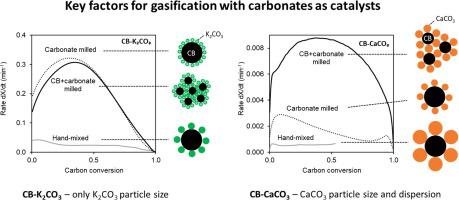Fuel ( IF 6.7 ) Pub Date : 2020-11-19 , DOI: 10.1016/j.fuel.2020.119677 Ross A. Arnold , Ingrid L. Motta , Josephine M. Hill

|
Gasification is often studied in the laboratory using a thermogravimetric analysis (TGA) unit with less than 1 g of sample in order to obtain intrinsic rates. Many studies, however, neglect to consider the impact of particle size, of both the gasification feed and the catalyst, and catalyst dispersion on the measured rates. The impact of these factors was demonstrated using catalytic gasification of carbon black, an ash-free feed, as a case study, with K2CO3 or CaCO3 as catalysts at 850 °C in a CO2 atmosphere. Hand-mixing and ball-milling were used to alter the initial parameters. Ball-milling reduced both the particle size of both species and increased the catalyst dispersion, resulting in higher interfacial areas and gasification rates than hand-mixing. The changes in gasification kinetics were estimated by modeling the rates using the random pore and extended random pore models (RPM and eRPM, respectively). The impact of the interfacial contact area between carbon and catalysts (varied by particle size and mixing method) was dependent on the activity of the catalyst with the more active (potassium) catalyst being less affected. CaCO3 was found to sinter at 850 °C, reducing available catalytic surface area and blocking CO2 access to the carbon feed. It is recommended to consider these factors in future studies and to always report the particle sizes used.
中文翻译:

在热重分析仪中测得的粒径和催化剂分散度对气化速率的影响:钾或钙催化的炭黑的案例研究
气化通常在实验室中使用热重分析(TGA)单元进行研究,其中少于1 g的样品才能获得固有速率。然而,许多研究忽略了考虑气化进料和催化剂的粒径对催化剂速率的影响。作为案例研究,在850°C的CO 2中使用K 2 CO 3或CaCO 3作为催化剂,使用无灰进料炭黑进行了催化气化,证明了这些因素的影响。大气层。手工混合和球磨用于改变初始参数。球磨法减小了两种物质的粒径,并增加了催化剂的分散性,与手工混合相比,产生了更高的界面面积和气化速率。通过使用随机孔模型和扩展的随机孔模型(分别为RPM和eRPM)对速率进行建模来估算气化动力学的变化。碳与催化剂之间的界面接触面积的影响(受粒度和混合方法的影响)取决于催化剂的活性,而活性较高的(钾)催化剂受到的影响较小。发现CaCO 3在850°C烧结,减少了可用的催化表面积并阻塞了CO 2获得碳饲料。建议在以后的研究中考虑这些因素,并始终报告使用的粒径。











































 京公网安备 11010802027423号
京公网安备 11010802027423号